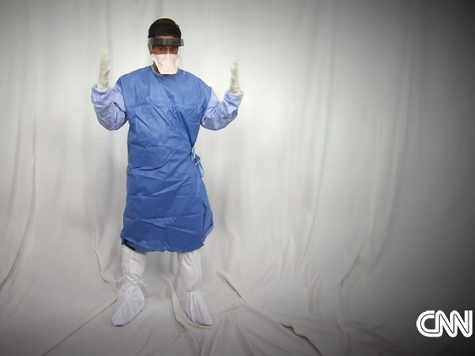AUSTIN, Texas — In a special video segment for CNN, CNN medical correspondent Dr. Sanjay Gupta discussed the protocols for caring for patients infected with Ebola, as recommended by the Center for Disease Control and Prevention (CDC).
Texas Christian University nursing graduate Nina Pham became the first person to contract Ebola on American soil after she cared for Thomas Eric Duncan at Texas Presbyterian Hospital in Dallas. As Breitbart Texas reported, Dr. Thomas Frieden, the head of the CDC, had made comments that there must have been a “breach in protocol,” and that Ebola infections “only occur when there is a breach in protocol,” comments which have been interpreted as blaming Pham for catching the highly contagious virus. Other Ebola experts and medical professionals have commented that proper compliance with the protocols is complicated and requires specialized training, and as Dr. Gupta demonstrated in the video, properly removing the protective gear is especially difficult.
“Some say [removing the gear] is the most dangerous part,” said Gupta, adding that the protective gear and the procedures for using it are different than the protective clothing that he and other medical professionals are used to wearing to keep operating rooms safe and sterile. The video shows Gupta put on a long-sleeved gown that goes past his knees, a face mask covering his nose and mouth, a clear plastic shield covering his entire face, coverings over his feet up to the knees, and plastic gloves on both hands, with his sleeves tucked into them for complete coverage. Gupta remarks that this is the CDC protocol, and it is different than how he suited up when he was visiting Ebola-stricken areas of Guinea.
Gupta then shows how the gear is supposed to be removed, using chocolate sauce as a visual aid to show how bodily fluid could possibly become a contamination. Several difficult moments Gupta encounters include removing the gown in one piece, removing the gloves without exposing any of the contaminant to his bare skin, and removing the mask and face shield without touching the sides.
After the demonstration was concluded, Gupta commented that “>obviously garb like this, like I was wearing, could work just fine in many situations,” there were three key vulnerabilities. First, not all his skin was covered, meaning that if there was splattering from a patient who was sick, bodily fluids could have gotten on his neck or one of the other exposed areas. Second, Gupta criticizes the CDC for not implementing a “buddy system” for putting on and removing the protective gear. Gupta notes that they used a buddy system when he was in West Africa, “someone sort of checking you at the beginning when you’re putting on your garb and also again at the end.” Third, the CDC protocols do not include a requirement to cleanse the hands before removing the gloves. The protocols Gupta’s team followed in Africa included dunking their hands (while still wearing gloves) in buckets of bleach on the way out from treating Ebola-infected patients.
Gupta also shared an alarming fact illustrating what a difference these protocols can make. In West Africa, volunteers with Doctors Without Borders have been treating Ebola patients for years, following the additional protocols that Gupta mentioned, and this year was the first where they had a patient transmit the virus to a health care worker. In contrast, when we had the very first patient diagnosed with Ebola in the United States, he is already known to have transmitted it to at least one health care worker. (The full incubation period for Ebola has not yet passed for everyone who had contact with Duncan.)
As Breitbart Texas previously reported, Gupta is not the first medical professional to question the CDC protocols and point out potential vulnerabilities. Among others, ABC’s chief health and medical editor, Dr. Richard Besser, has directly contradicted the CDC’s statements that any American hospital can safely treat Ebola patients, arguing that only a few facilities around the country truly have the advanced biocontainment equipment, as well as the expert training needed to implement it properly.
Follow Sarah Rumpf on Twitter at @rumpfshaker.

COMMENTS
Please let us know if you're having issues with commenting.